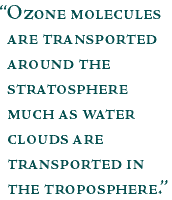

Since the 1920's, ozone has been measured by ground-based instruments. Scientists place instruments at locations around the globe to measure the amount of ultraviolet radiation getting through the atmosphere at each site. From these measurements, they calculate the concentration of ozone in the atmosphere above that location. These data, although useful in learning about ozone, are not able to provide an adequate picture of global ozone concentrations. The amount and distribution of ozone molecules in the stratosphere varies greatly over the globe. Ozone molecules are transported around the stratosphere much as water clouds are transported in the troposphere. Therefore, scientists observing ozone fluctuations over just one spot could not know whether a change in local ozone levels meant an alteration in global ozone levels, or simply a fluctuation in the concentration over that particular spot. Satellites have given scientists the ability to overcome this problem because they provide a picture of what is happening daily over the entire Earth. The United States satellite measurement program for ozone, run jointly by NASA and the National Oceanic and Atmospheric Administration (NOAA), has measured ozone distribution by season, latitude, and longitude, and has observed long-term changes over more than 20 years using a variety of satellite instruments. The instruments in use today will be replaced over the next five to ten years by a new generation of improved, more sophisticated instruments. Stratospheric ozone is being depleted worldwide—partly due to human activities. Scientists now know that the large polar ozone losses are a direct result of the effects from human-produced chemicals. However, scientists still do not know how much of the mid-latitude loss is the result of human activity, and how much is the result of fluctuations in natural cycles. Predicting Ozone Levels
Much remains to be learned about the processes that affect ozone. To create accurate models, scientists must study simultaneously all of the factors affecting ozone creation and destruction. Moreover, they must study these factors from space continuously, over many years, and over the entire globe. NASA's Earth Observing System (EOS) will allow scientists to study ozone in just this way. The EOS series of satellites will carry a sophisticated group of instruments that will measure the interactions within the atmosphere that affect ozone. Building on the many years of data gathered by previous NASA and NOAA missions, these measurements will increase dramatically our knowledge of the chemistry and dynamics of the upper atmosphere and our understanding of how human activities are affecting Earth's protective ozone layer. back: Ozone Depletion
|

Ozone | ||||